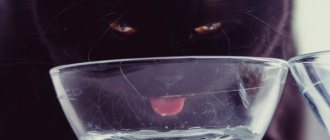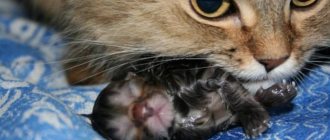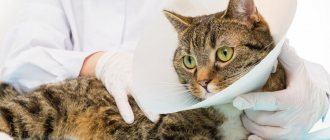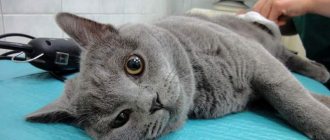When purchasing a cat, you need to understand that over time it will grow up and often produce offspring. These animals are particularly fertile and can give birth up to 3 times a year. How many kittens does a cat give birth to for the first time is a question that interests every owner. A lot or a little, and what if there is just one or seven? Of course, having many kittens is difficult for both the pet and the owner, because, in the end, he will have to place them in good hands.
And not all furry murkas are titled, where the waiting list for their children is scheduled for years in advance. And if you are against sterilization, then you need to study everything about the cat’s pregnancy and the birth process. Because at least once a year you will have to take them. I would also like to note that domestic pets are less adapted to life compared to their street relatives, so they often require the help of their owner, and sometimes a veterinarian. So, let's talk a little about cat pregnancy itself.
How many kittens can a cat give birth to?
If we consider averages, then an ordinary cat can give birth to 6-8 babies at a time. However, the number of cubs is not just the will of fate, but a confluence of many factors. There is a case in history when a representative of the Persian breed gave birth to 15 kittens at once. It is also not uncommon for 1-2 babies to be born. So, what will determine the number of future babies?
Features of the female body
How many kittens a cat gives birth to depends, first of all, on the characteristics of her body. The first birth is usually a surprise, and then the owners know roughly what to expect from their pet. What will affect the female's fertility:
- Age
: Primiparas and late-parous women are unlikely to have many babies. Most likely there will be about 1-2 cubs.
- Genetics
: if the cat’s mother was fertile, then the daughter will most likely inherit this quality.
- Size
: a miniature cat, even in its prime, will not bring too many kittens, but a large and well-fed female is capable of regularly giving birth to a large number of babies.
- Health
: if the cat has any problems, then she will bring significantly fewer kittens.
If you know the cat’s mother and this is not the first time you have observed childbirth, then it will not be difficult to determine the approximate number of fetuses even without an ultrasound.
Male fertility
The number of offspring is influenced by the characteristics of your cat's partner. For example, his age: if the cat has not reached 1.5-2 years of age or, conversely, is too old, the quality of his semen will be an order of magnitude lower than that of strong and healthy cats. Pay attention to the frequency of matings of the cat - you should not expect a large litter if he fertilizes more than 4 cats per year.
The father's health is undoubtedly one of the most important factors. Infectious diseases or diseases associated with the reproductive system can affect not only the number and condition of the offspring, but also the health of the mother herself. If you have a purebred cat and are looking for a mating partner, be sure to ask for a health certificate, the necessary documents on purebred, and also ask the owners how many kittens are usually born from a given male.
An amazing feature is characteristic of cats - in one litter there can be fruits from completely different fathers. This is due to the fact that eggs in the body are produced directly during mating. Therefore, outdoor cats produce more kittens than planned breeding pets.
Dependence on breed
Without a doubt, the fertility of a furry mother is also influenced by her breed. Surely you have noticed that ordinary street cats often give birth more than indoor cats? This is due to a simple truth - harsh conditions await children on the street, and the chances of survival are much less than at home. Therefore, to continue the race, a larger number of kittens is needed.
Purebred pets are not so fertile. For example, Scottish women give birth to an average of two or three babies at a time, but British representatives are already capable of bearing 4-5 babies. However, not everyone can master even this breed maximum.
What determines the number of kittens?
- The very first factor is age. As already mentioned, a small number of young individuals, primiparous and old-parous, give birth.
- Hereditary factor. If the expectant mother was from a large litter, then the chances of giving birth to many kittens increase, and vice versa, if the litter was small, then you need to expect few kittens.
- The pet's health status. Weakened cats that do not receive the necessary vitamins and do not have adequate nutrition are physically unable to bear and give birth to many kittens; they usually give birth to up to 3 babies. Healthy and active
- Pedigree cats give birth to fewer children than their outbred counterparts.
- Conditions of detention. Cleanliness, comfort, stress-free life.
- Nutrition. It must be balanced and complete; if there are no nutrients in the cat’s body, it will be difficult for her to become pregnant.
- The presence of infectious diseases can affect the ability to conceive and bear healthy offspring.
- The cat's temperament plays an important role. The more love games that happen between him and the cat, the higher the probability of fertilization of more eggs, which directly affects the number of offspring.
If the cat is pregnant for the first time
Owners often wonder if a cat can give birth to one kitten? If your pet is pregnant for the first time, it is unlikely that her litter will be large. Most likely, 2-3 kittens will be born, or even just one.
The fact is that the cat's reproductive system can only be fully formed after the first pregnancy. A future furry mother can become pregnant as early as 8 months, but this does not mean that such an early pregnancy is desirable. At the age of up to 1 year, her body is so delicate that carrying even one fetus is a risky step. Here it is important to determine not how many kittens a cat gives birth to for the first time, but how she will cope with motherhood and whether her health will be undermined.
Of course, in nature no one keeps track of when cats mate or don’t mate. But at home, a caring owner should not allow early mating at least until 1.5-2 years.
How often can you give birth?
A sensitive issue that worries good owners concerns how often a cat can give birth. There are several opinions that differ significantly.
Note! When making a decision, it is worth considering the cat's health characteristics.
Veterinarians and professional breeders of certain breeds give different recommendations regarding the frequency of lambing.
Fans adhere to completely different norms, dosing cats with hormonal pills at the time of estrus to stop the process.
How often can a cat give birth:
| Who makes the recommendation regarding the issue? | Top advice regarding lambing |
| Experienced cat breeders | It is recommended to breed a female according to the plan. Typically lambing is planned once a year. It is believed that the female’s body is in harmony and the quality of the litter will be much better |
| Experienced hosts | They say that it is enough for a cat to give birth 2 times a year. This will allow you not to overstrain your body and keep it in good shape. Otherwise, the animal begins to get sick often and behave inappropriately. |
| Veterinarians | Catch a cat when it comes into heat. Therefore, births may not be limited to 3-4 in 1 year. If the animal's needs are ignored, health problems may arise, leading to infertility and even death. |
Minimum and maximum
Surely your cat periodically gives birth to 4 to 6 kittens - this is the average for representatives of all breeds. There are also cases of the birth of 8 or more cubs. The fact is that a furry mother has a certain limit - a certain number of babies that she can feed. Their number should not exceed the number of her nipples. If there are more than eight kittens, one will not get milk, which means the baby may die. Then the owners will have to help the young mother feed her offspring.
The minimum number of kittens is one; there are cats that, due to genetic and physiological characteristics, are not able to conceive and bear a large number of fetuses. If your cat usually gives birth to around five babies and suddenly gives birth to one, you should take her to the vet - there is most likely something wrong with her health.
How many kittens can a cat give birth to maximum? It’s hard to say, the known documented limit is 15 pieces. But in general, the number of kittens over 10 is already rare. In purebred animals, the threshold is even lower - they rarely reproduce more than 6 kittens.
An older mother will no longer give birth to the same large litter as in her best years. The reproductive system wears out over time, and the likelihood of a difficult pregnancy increases. It is better to protect your cat from mating after reaching 8-10 years of age.
Norm of multiple births for cats
Man has done a lot to change the cat. Numerous breeds have been bred in which certain beneficial properties have appeared to replace the loss of others. As a result, purebred felines rarely give birth to more than five kittens, and their yard companions set records, giving birth to 10–15 cubs. There is a belief that a cat is capable of giving birth to two kittens less than she has nipples. Their number in most individuals is eight, but can range from 6–11.
recommended articles:
- What is eclampsia in cats?
- Signs of false pregnancy in cats
How to determine the number of kittens in a pregnant cat
If you want to find out how many kittens a cat will give birth to, there are several proven methods:
- Based on genetic data. How many babies did your pet's mother have in her litter on average? Most likely, this factor was inherited from her. If the cat's grandmother had an average of 6 goals at a time, then your pet will have the same number. She is unlikely to give birth to more than her ancestors gave birth to.
- Folk way. Count how many mammary glands the cat has swollen during pregnancy? Then subtract two from their number. Of course, no one can guarantee the effectiveness of such a result, but it is used quite often.
- Scientific method. One of the simplest and most common ways to find out how many kittens a cat will give birth to today is ultrasound. It is done 10-14 days before birth, this will allow you to determine the exact number of fetuses.
Under no circumstances should you try to count the number of fetuses in a pregnant cat by palpating her. This can affect the health of future babies and cause stress for the mother herself. The maximum that can be done is to gently stroke the tummy if the cat exposes it herself.
Keep a close eye on your pet. If she had more than one partner at the beginning of her pregnancy, then she is likely to give birth to both fathers, which means that the number of cubs will be greater than usual.
Factors influencing gestation period
How long a pet's pregnancy will last depends on a number of factors. For example, the weight of the animal is important. If you are obese or underweight, it is more difficult for a female to bear offspring, so the timing may vary.
How many days does a cat walk: examples for the first time and how long in time
If fertilization occurs for the first time in a pet that is younger than 8 months, then it will be more difficult to bear healthy offspring. In such cases, pathologies of fetal development, as well as difficult childbirth, are often observed.
Important! Hormonal imbalances greatly affect the timing of gestation.
The presence of chronic infectious diseases leads to the fact that the due date may shift. During planning of mating, as well as pregnancy, it is necessary to carefully monitor the well-being of the pet in order to eliminate the risk of miscarriage.
Often times are even affected by weather conditions, changes in seasons or climate zones.
How to increase the number of kittens in a litter
This question is most often asked by those owners who are planning to breed and breed a purebred pet. It is important to understand that this is not a simple matter at all, since any mistake can have a detrimental effect on the health of the animal. Be careful not to cause any harm.
The main way to increase fertility, of course, is medications. First of all, you should pay attention to homeopathic remedies. Now in almost every pharmacy you can find at least several products that are not harmful to your pet’s health. Especially notable among them are Gamavit and Ovariovit - these drugs have a beneficial effect on the reproductive system of the expectant mother and help eggs to form in large volumes.
You can contact your veterinarian and consult with him about taking supplements such as selenium and vitamin E. Only a specialist can prescribe exact dosages based on the breed, condition and physiology of the expectant mother. Under no circumstances should you give your cat supplements yourself, otherwise there will be a risk of metabolic disorders and the development of diseases on this basis.
The process of preparing your pet for pregnancy should begin long before mating. If she is already pregnant, there is no point in doing anything.
Signs of cat pregnancy
Cats reach sexual maturity at 7-9 months, but mating too early is not recommended: the offspring may be born weak or the cat’s body may not be able to withstand such an overload. After the cat is one year old, you can take her to mating. After 2-3 weeks, the first signs of pregnancy may appear: the animal’s nipples turn pink and swell - this is especially noticeable if it is the first pregnancy.
In the first month, the animal’s activity decreases significantly; the pet may vomit in the morning - this is due to hormonal changes and changes in the body. As a rule, after 2-3 weeks everything gets better, and the cat begins to eat much more. On approximately the 20th day, palpation can reveal pregnancy; however, this procedure cannot be performed on your own - you may accidentally harm the developing offspring.
By 4-5 weeks, the cat begins to gain weight: changes reach 1-2 kilograms, depending on the number of offspring being carried. The bone structure of the fetus can be seen on days 44-43 on an x-ray, but it is not recommended to take an x-ray unless absolutely necessary. The cat's taste preferences may also change, mood swings appear, after 6 weeks the belly grows more and more, the animal walks more slowly, sometimes waddles.
At 7-8 weeks, the pet begins to look for a “nest”, show nervousness and anxiety, at this time you can feel the active movements of the kittens - just put your hand on the cat’s belly. At week 9, milk appears in the mammary glands, the cat lies down more and moves less. If there are numerous offspring, the cat's pregnancy may be shorter; post-term pregnancy for more than 70 days is dangerous for the health of the mother and kittens - in this case, you should consult a veterinarian.
In one litter, cats can give birth to from 1 to 10 kittens; these animals have a different structure of their reproductive organs: the shape of a cat’s uterus is similar to the letter Y, it is much shorter than the human uterus, which also looks like a pear. After fertilization, the embryos are evenly fixed in the processes of the uterus, so that multiple pregnancies do not cause much harm to the cat herself.
Is it better to have a little or a lot?
Definitely, every owner wants his purebred pet to produce as many furry babies as possible. But it is important to observe moderation - the more fetuses in the womb of an animal, the higher the likelihood of complications during childbirth. This is especially true for young individuals and those who are already aged.
Even a healthy cat is unlikely to be able to feed a litter that is too large. Not only will the babies squeeze all the juices out of it, but there is also a high probability that there will not be enough mother’s milk for everyone. Too much pregnancy often leads to the death of part of the litter in the womb, because the cat’s body cannot cope with such a colossal load.
If a mother gives birth to only a few babies, this risks one of them getting stuck in the birth canal, from where it is usually pushed out by a whole line ready to be born. The fact is that kittens born alone or with 1-2 brothers are an order of magnitude larger than usual. If such an incident occurs, the mother needs an urgent caesarean section, otherwise she may die along with the baby. Excess milk in the glands can also lead to unfavorable events - for example, mastitis.
Of course, the golden mean is the ideal option. It is much better if a pet gives birth to 4-6 healthy ones than 10 weak babies that she cannot even feed. For the most purebred representatives, their own health is much more important than the excessive number of litters - after all, if any serious problems arise, there may be no offspring at all.
What is better: small or multiple pregnancy?
Typically, not all breeders welcome multiple pregnancies. This is fraught with waste from a financial point of view, but it is also not safe for the physical health of the cat. A large number of children will tire the mother, they all need to be fed, and if there is not enough milk, you will have to buy formula - this is already a considerable waste item.
If the pregnancy is small, there is a risk of rupture during childbirth with a variety of consequences. Also, the kitten may get stuck during birth and an emergency caesarean section will have to be performed. Excess milk can lead to mastitis.
The golden mean is good in everything and in the birth of kittens too.
Features of pregnancy and preparation for childbirth
Pregnancy in cats lasts on average 63-65 days. By the middle of the term, a noticeable belly grows. When stroking, you can feel that it is dense and slightly elastic. After another week, the fruits can already be felt a little. It is better to entrust this to a doctor, because under no circumstances should you press too hard or for too long. At this stage, the kittens are already beginning to descend into the lower abdomen.
Over the course of 6-7 weeks, the belly grows a little more, and the mother begins to prepare for childbirth. Now, if you put your hand on her stomach, you will clearly feel something moving inside. From the 8th week until the birth, the mother cat no longer has the strength to move, so make sure that she has a quiet and calm place somewhere in a wide basket or box. Bring her food and water.
During childbirth, you can help your pet by lightly stroking her belly from top to bottom. But in general, childbirth goes quickly and without complications. After it's all over, leave her alone with the kids.
Do you like the article? 503
Search for a place
A place for a woman in labor can be arranged on a bed or using a tray. The most suitable option is a cardboard box, the bottom of which is covered with paper. Qualities that a birthing place must meet:
- The box should be closed, but large in size, since the animal will live there with the kittens for several months.
- For convenience, one wall of the box is cut off. This will allow the cat to freely enter the bed area without jumping over the barrier each time.
- The prepared house is installed in a quiet place, closed from prying eyes. This could be the bathroom, a corner of the room behind the sofa, or a closet.
If the cat ignored the chosen place and hid in the closet, this is an indicator that it lacks silence and feels unprotected.
Advice for owners of young cats
It is better to keep an eye on your cat on the day of birth. It is very easy to define. She will rush around the room in search of a suitable place, will rarely stop, will often sit down on the floor and reach out to lick herself, since the natural process for her is to lick the broken water. However, it will still leave wet marks on the floor.
“Primiparous”, that is, young, cats have the most difficult time. They have no experience and therefore, during childbirth and on the day of its approach, they are overcome by panic. The cat should prepare the birthing area in advance. A box with soft bedding will also work. It is worth placing it there at least once a day and explaining to the animal that there is no danger for it here. Perhaps indulge in your favorite food.
During the birth itself, the cat may become confused and rush around the box. In this case, the first born kittens should be placed on a soft diaper and covered with it to keep them warm. When the second kitten comes out and the cat understands the algorithm of actions and understands your support, you can return the first one to her.
After giving birth, it is worth monitoring the feeding process. It should happen once every two hours. Not more often and not less often. You can gently push the kittens towards the nipples so that they eat. The process itself should last no more than five minutes. Then the kittens and cat will be healthy and happy.











